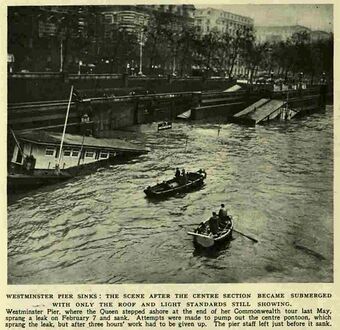The Sinking of Westminster Pier: Difference between revisions
No edit summary |
No edit summary |
||
| Line 44: | Line 44: | ||
*[[Max Geldray]] plays ''[[Aquarela do Brasil|Brazil]]'' {{small|([[Ary Barroso]])}} | *[[Max Geldray]] plays ''[[Aquarela do Brasil|Brazil]]'' {{small|([[Ary Barroso]])}} | ||
*[[Ray Ellington|The Ray Ellington Quartet]] plays ''Lean Baby'' {{small|([[Billy May]])}} | *[[Ray Ellington|The Ray Ellington Quartet]] plays ''Lean Baby'' {{small|([[Billy May]])}} | ||
==Transcription== | |||
*[[The Sinking of Westminster Pier (Transcript)|TThe Sinking of Westminster Pier (Transcript)]] | |||
==Technical== | ==Technical== | ||
| Line 56: | Line 59: | ||
[[Category:Ted Kendall restored Goon Show episodes]] | [[Category:Ted Kendall restored Goon Show episodes]] | ||
[[Category:Goon Shows produced by Peter Eton]] | [[Category:Goon Shows produced by Peter Eton]] | ||
[[Category:Goon Show episodes with transcription]] | |||
Latest revision as of 21:31, 15 September 2024
| "The Sinking of Westminster Pier" | |
|---|---|
| The Goon Show episode | |
 The sinking of Westminster Pier | |
| Episode: no. | Series: 5 Episode: 21 |
| Written by | |
| Announcer | Wallace Greenslade |
| Produced by | Peter Eton |
| Music |
|
| Recording Number | TLO 72450 |
| First broadcast | 15 February 1955 |
| Running time | 30:53 |
The Sinking of Westminster Pier is an episode from The Goon Show. It is the twenty-first show in the fifth series. It was originally billed in the Radio Times as The Six Ingots of Leadenhall Street but at short notice the show was changed based on a news story about the appearance of a photograph showing Westminster's floating pier not floating particularly well being under several feet of water. Further ignominy was added to the pier by an "Out of Order" sign being pinned to the entrance. Greenslade attempts to announce the show as The Six Ingots of Leadenhall Street (based on the assumption that the Radio Times is never wrong!). Eventually Peter Sellers announces the title as "The Port of London Authority's valuable hand-carved, oil-painted, valuable floating pier".[1]
The show was recorded at 9.15pm on Sunday 13 February 1955. The recording took place at the Camden Theatre, Camden Town, London.
The first British public broadcast was on the Home Service on Tuesday 15 February 1955 at 8.30pm . It reached a peak listenership of 4.5m.
The show's first repeat was the following Friday at 12.25pm / 12.30pm (depending on the area), 18 February 1955, on the Home Service. It was listened to by 2.3 million. The next repeat was 15 years later on Sunday 22 August 1970 at 8pm in the evening, where it attracted 0.6m listeners.
Transcription Service Synopsis

On the 7th February 1955, the Port of London's valuable Westminster Pier sank. Who was responsible? Chairman Mr Neddie Seagoon was determined to find out, and engaged the services of Mr Henry Crun, the international oyster sexer; but Mr Crun's novel scheme ended in failure. Then a representative of Messrs, Fred Moriarty Limited, sunken Westminster Pier floating salvage expert, happened to meet Neddie accidentally and affairs took a brighter turn. With the arrival of the Honourable Grytpype-Thynne, the world's greatest water remover, with a scheme to drain the Thames and leave the pier high and dry, Seagoon foresaw success. But then someone disguised as a Bluebottle put dynamite into the water pumps. Who could it have been?
Music
- The BBC Radio Orchestra was conducted by Wally Stott
- Max Geldray plays Brazil (Ary Barroso)
- The Ray Ellington Quartet plays Lean Baby (Billy May)
Transcription
Technical
Originally recorded on TLO 72450 (15 ips ¼" tape recorded at Broadcasting House). This tape survived in Transcription Services until 1970 when it was destroyed. The version of the show included on Compendium Volume 2 was sourced from the BBC Sound Archive shelf copy (T 28582) which was dubbed to DAT in 1990.[2]
References
- ^ Wilmut, Roger (1976). The Goon Show Companion. Robson Books. p. 123. ISBN 0860518361.
- ^ Kendall, Ted (2009). The Goon Show Compendium Vol 2 (Booklet 2). BBC Worldwide. p. 11. ISBN 978-1-4056-8774-4.